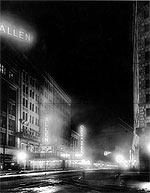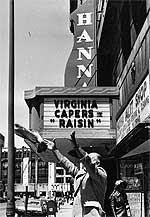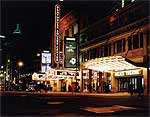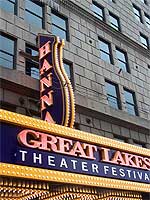A timeline of important events in the history of Playhouse Square
| Date |
Event |
| 1916 |
Joseph LaRonge, know as the "Father of the District" presents his plans for a Theatre District in Cleveland to leaders in the Theatre profession. LaRonge forms a partnership with Marcus Loew and others to build Playhouse Square over the next five years. |
| Feb. 5, 1921 |
The State Theatre opens with a silent film A Polly with a Past, with music by the Hyman Spitolny Orchestra. |
| Feb. 14, 1921 |
The Ohio Theatre opens with a David Belasco production of The Return of Peter Grimm. |
| March 29, 1921 |
The Hanna Theatre opens with The Prince and the Pauper |
| April 1, 1921 |
The Allen Theatre opens with the movie The Greatest Love, with music by the Phil Spitolny Orchestra. |
| Nov. 6, 1922 |
The Palace Theatre opens as the flagship of the Keith Vaudeville chain with Elsie Janis as the headliner. Janis had been a headliner in vaudeville for over 20 years by this time, performing in New York and London. |
| 1922 |
Loews takes over management from the Allens of the Allen Theatre. |
| 1924 |
The Korner & Wood bookstore moves to Playhouse Square where it stays in business until 1965. |
| Jan. 11, 1925 |
Ethyl Barrymore appears in The Second Mrs. Tanqueray at the Ohio. |
| May 23, 1926 |
Movies are included between live acts at the Palace. The first movie is The Volga Boatman. |
| Dec. 25, 1926 |
Katherine Cornell debuts at the Hanna in the first of her 22 performances at that theater,
more than any other performer. |
| Nov. 18, 1929 |
Judith Anderson appears in Eugene O’Neill’s Strange Interlude at the Ohio. |
| 1932 |
RKO takes over the Allen Theatre |
| Herman Pirchner opens the Alpine Village Nightclub at Playhouse Square. |
| Dec. 1932 |
2-a-day vaudeville is dropped in favor of continuous vaudeville with
movies. This ends the era of "big time" vaudeville in Cleveland |
| Oct. 22, 1935 |
The Ohio Theatre is converted into the Mayfair Casino, closing in December of 1936. |
| Dec. 30, 1936 |
Maxwell Anderson’s High Tor has its world premier at The Palace. |
| 1941 |
Milton Krantz becomes the manager of the Hanna, a position which he holds until 1983. |
| 1942 |
Radio programs to promote War Bond Sales begin to be broadcast from the Palace. |
| Jan. 14, 1943 |
The USO opens a "Stage Door Canteen" on Playhouse Square for servicemen. |
| Sept. 23, 1943 |
The Ohio Theatre opens as part of the Loew’s Movie Chain with For Whom The Bell Tolls. |
| Oct. 31, 1945 |
Vaudeville ends at the Palace Theatre. |
| 1950s-1960 |
Only the Hanna Theatre continues to feature live entertainment and Broadway shows. The suburbs are developed and first-run movies now open in the shopping Malls. |
| April 20, 1953 |
Rodgers and Hammerstien’s Me and Juliet makes its world premiere at the Palace. |
| 1957 |
The State Theatre introduces Cinerama. |
| 1960 |
The Palace Theatre is renovated. |
| 1961 |
The Allen Theatre is renovated at a cost of $500,000. |
| The Alpine Village closes. |
| July 05, 1964 |
The lobby of the Ohio Theatre is destroyed by fire. |
| May 7, 1968 |
The Allen Theatre closes. |
| Feb. 02, 1969 |
The State and Ohio theaters close. |
| July 20, 1969 |
The Palace air conditioning breaks down during a showing of Krakatoa East of Java, causing the Palace to close. |
| Feb. 05, 1970 |
Ray Shepardson, an employee of the Cleveland Board of Education, first sees the closed State Theater while looking for a location for a teachers conference. |
| Feb. 27, 1970 |
Life Magazine features The Spirit of the Cinema -- America, one of four murals painted by James Daugherty for the lobby of the State
Theater, on its cover. This generates interest in Playhouse Square. |
| July 1970 |
Shepardson and other civic leaders, along with the Junior League formed a nonprofit group, the Playhouse Square Association whose goal was the restoration, operation, and management of the theaters. Shephardson headed the Association, which in now known as the Playhouse Square Foundation, until 1979. |
| April 25, 1971 |
A bomb explodes in front of the Hanna Theatre during the theater’s run of Hair. |
| Nov. 1971 |
The Budapest Symphony Orchestra appears at the Allen Theatre as the first event of the Playhouse Square Association. |
| May 1972 |
The State and Ohio comes within days of being demolished and turned into downtown
parking. The Junior League pledges $25,000 to help save them. |
| April 18, 1973 |
Jaques Brel is Alive and Well and Living in Paris opens in the State Lobby Cabaret for a two year run. Intended to run for only three weeks, it runs for 522 perfomances. |
| Aug. 1973 |
The Playhouse Square Foundation is formed and shortly obtains long term leases on the Palace, State and Ohio. |
| Nov. 5, 1973 |
Ben Bagley's Decline and Fall of the Entire World as Seen Through They Eyes of Cole Porter opens at the Palace. |
| 1977 |
The Allen Theatre beomes the "Laserium," a short-lived laser light theater. |
| Dec. 1977 |
Cuyahoga County purchases the Loew’s building to secure the future of the State and Ohio. |
| Oct. 1978 |
The Playhouse Square Theatres are listed in the National Register of Historic Places by the United States Department of the Interior |
| March 1980 |
The Playhouse Square Foundation launches an $18 million fundraising drive to restore the State, Ohio and Palace. |
| July 9 1982 |
The Ohio Theatre re-opens as the home of the Great Lakes Shakespeare Festival. |
| June 11, 1984 |
The State Theatre reopens with the Metropolitan Opera’s production of Peter Grimes. |
| Feb. 1987 |
Restoration of the three State Theatre lobbies is finished. |
| April 30, 1988 |
The Palace Theatre reopens. |
| 1989 |
The Hanna Theatre closes. |
| July 20, 1995 |
The Wyndham Cleveland at PlayhouseSquare hotel opens. |
| March 1996 |
The Hanna Theatre is reopened by former Playhouse Square Foundation president Ray Shepardson |
| Sept. 19, 1996 |
Star Plaza, a public Park in Playhouse Square is completed |
| 1997 |
The Playhouse Square Foundation purchases the Allen Theatre. |
| 1998 |
Playhouse Square Foundation acquires the One Playhouse Square Building. |
| Oct. 02, 1998 |
The Allen Theatre is renovated and reopened. |
| Oct. 3, 1998 |
For the first time in decades all 5 theatre marquees are lit at the same time. |
| 1999 |
The Playhouse Square Foundation purchases the Hanna Building and takes control of the
Hanna Theatre, bringing the 5 theatres under the same ownership for the first time. |
| March 2003 |
Restoration of the four large James Daugherty murals “The Four Continents” is completed by the Intermusuem Conservation Association. |
| Oct. 15, 2004 |
Cleveland State University releases a study of the economic impact of the theater activities of Playhouse Square Foundation; $43 million per year. |
| 2005 |
The Playhouse Square Building is renovated and reopens as the Idea Center. This is a collaboration with local public radio (90.3 WCPN) and television stations (WVIZ/PBS, The Ohio Channel) collectively known as Ideastream. |
| Sept. 20, 2008 |
The Hanna Theatre is renovated and reopens as the new home of the Great Lakes Theater Festival. |
| April 8, 2009 |
The Cleveland Playhouse, at 8500 Euclid Ave., announces it will move to Playhouse Square. The Allen Theatre will be renovated and two new theaters will be built. |














